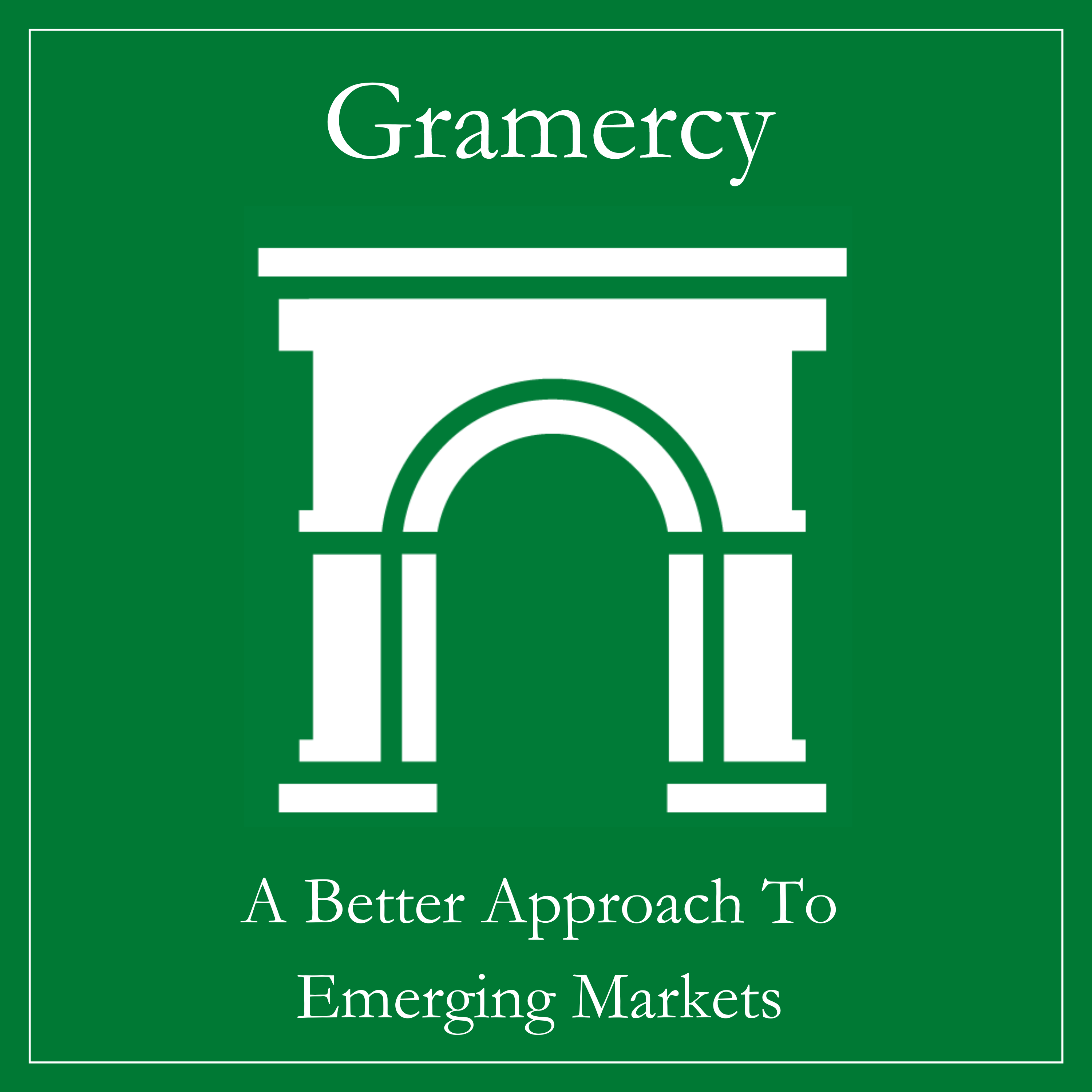Contents
Market Overview
Macro Review
Following the Fed’s hawkish rate cut on December 18th, markets are now poised for any policy messages from the incoming Trump Administration. The year-to-date upside pressure on the 10Y U.S. Treasury yield is possibly also reflective of the belief that some of the new policies could be inflationary. From a technical standpoint, it looks as though the 4.75% and 5.00% yield marks are the next important psychological yield levels to focus on, with U.S. data releases obviously continuing to play an important role. While there were some signs of softer labor market data in H2-2024, the January 2025 non-farm payrolls reading surprised meaningfully on the upside. Markets are currently not pricing in any rate cuts from the Fed in H1 2025, especially as inflation is proving to be somewhat sticky as we enter 2025, with lower base effects from January and February 2024 taking their toll, too. EM USD bond spreads, meanwhile, have continued to fall, led mainly by high-yield (HY) sovereign bonds across various EM regions. African USD bonds are again outperforming peers on a total return basis, while investment grade sovereigns, including the likes of Saudi Arabia, Poland, Indonesia, Hungary and Mexico kicked off the bond issuance season. Otherwise, markets will be closely following any stimulus messages coming out of China, as deflationary fears remain and the leadership prepares for any increased tariff pressure out of the U.S. On the geopolitical front, good news to see Lebanon finally electing a president. Looking ahead, the country faces many economic challenges but will hopefully benefit from international recovery support.
EM Credit Update
This week, U.S. and German equities led the way ahead of U.S. HY and EM bonds (local and hard currency). EM equity indexes are going to need a boost from Chinese official policy impulses as the country gradually heads into its end-month New Year break. The latest official comments point to an increase in fiscal spending to deal with “new domestic and external problems”.
The Week Ahead
Next week sees several Fed speakers, including Mssrs. Schmid and Williams on January 14th. Otherwise, the focus will be on the January 15th U.S. CPI and the January 16th U.S. Retail Sales. The Eurozone faces an expectedly challenging industrial production release on January 15th, the same day that UK CPI is released, while UK retail sales are set for January 17th. The 17th will also present China’s Q424 GDP and December retail sales data for any further clues of real economy weakening.
Highlights from emerging markets discussed below: Lebanon elects President in a constructive step, but the harder chapter on political and economic reconstruction begins now and China manufacturing and price weakness partially offset by services strength in December.
Fixed Income
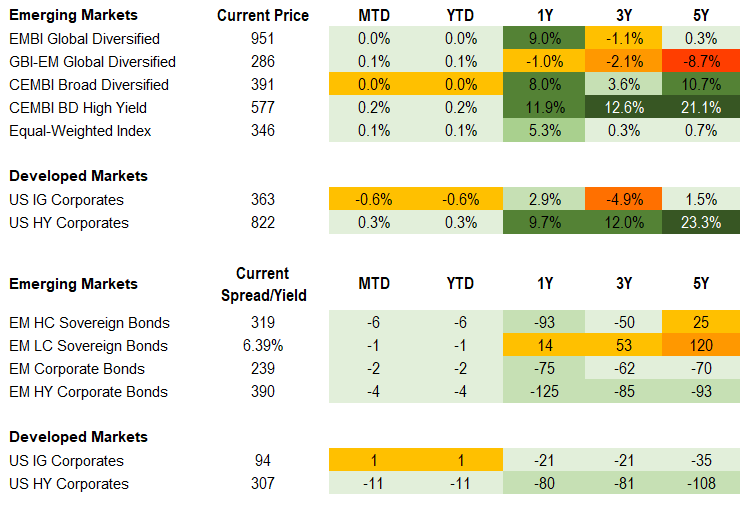
Equities
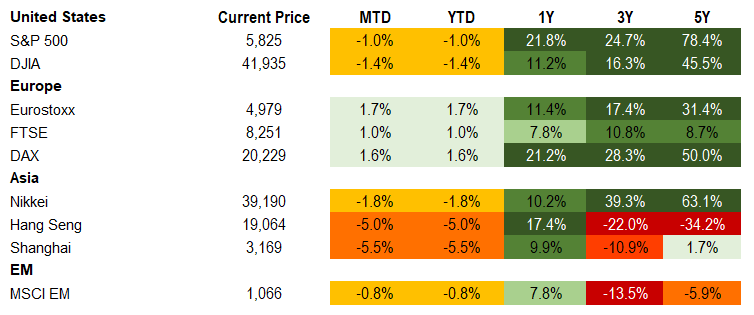
Commodities

Source for data tables: Bloomberg, JPMorgan, Gramercy. EM Fixed Income is represented by the following JPMorgan Indicies: EMBI Global, GBI-EM Global Diversified, CEMBI Broad Diversified and CEMBI Broad High Yield. DM Fixed Income is represented by the JPMorgan JULI Total Return Index and Domestic High Yield Index. Fixed Income, Equity and Commodity data is as of January 10, 2025 (mid-day).
Emerging Markets Weekly Highlights
Lebanon elects President in a constructive step, but the harder chapter on political and economic reconstruction begins now
Event: The Lebanese Parliament elected Joseph Aoun, the national army’s top Commander, as the country’s President, reaching a consensus on a candidate after a 26-month political vacuum without a President. Mr. Aoun’s election comes on the heels of a ceasefire agreement between Israel and Hezbollah, the Iran-affiliated militant group that came to dominate Lebanese politics in the last two decades.
Gramercy Commentary: Mr. Aoun ascends to the Presidency with support from both the U.S. and Saudi Arabia, arguably the two key external counterparties when it comes to provision of economic and geopolitical assistance as well as reconstruction funds for Lebanon. If he proves to be a reform-minded leader who catalyzes further improvement in Lebanon’s notoriously complex and frequently dysfunctional political environment, Aoun’s election could be the beginning of the end for Lebanon’s deep political and economic crisis over the last few years. Yet, the hard work for Lebanese policymakers and the international community is just about to begin. For starters, it is unclear to what extent Hezbollah’s (and Iran’s) domestic political influence has been diminished. That would be the key pre-condition for meaningful support by the GCC and/or the West. Lack of domestic political consensus on the economic path forward could present a significant obstacle on the path to normalization, as well as potential renewed political uncertainty related to parliamentary elections scheduled for mid-2026. Negotiations with the IMF over a new program, ultimate decisions on loss distribution from the banking sector restructuring, and the scale/sustainability of macroeconomic adjustments are just a few of the many elements that need to be resolved to pave the way toward a sovereign debt restructuring. Back of the envelope calculations point to haircuts in the 70-80% range needed to restore debt sustainability over the medium-term with most key macro variables still subject to substantial uncertainty. Market optimism about Lebanon’s recent developments have propelled the distressed sovereign bonds complex to trading in the high teens from single digits, but a break into the 20s is likely to require many pieces of the puzzle to fall in the right places in addition to optimistic assumptions about the medium-term macro-outlook, in our view.
China manufacturing and price weakness partially offset by services strength in December
Event: The NBS and Caixin PMI surveys showed easing in manufacturing components led by new orders and export orders while services sub-indices ticked upward. All indices remained in positive territory. Meanwhile, PPI and CPI hovered at depressed levels of -2.3% y/y and 0.1% y/y, respectively.
Gramercy Commentary: While the economic data is lackluster, the recent moderate strength in services and previous months’ moderate rebound in manufacturing likely support authorities’ preference for a still incremental and targeted stimulus approach. Given the importance of the external sector as an economic engine, last month’s softening in manufacturing is unwelcomed in the context of the uncertain tariff policy ahead while weak producer and consumer price dynamics continue to reflect ongoing structural challenges and growing expectations for Japanification over the medium-term. As such, we continue to expect a step-up in economic measures in 2025 with effectiveness to be determined by the scope and nature of the measures.
Emerging Markets Technicals
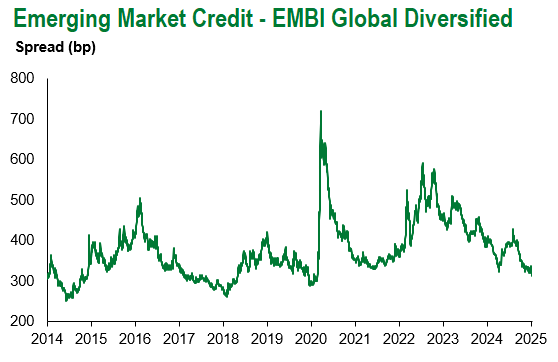
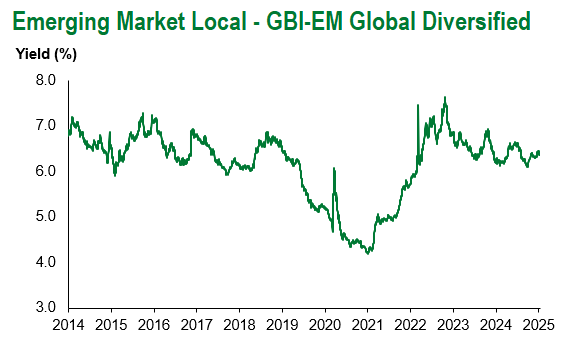
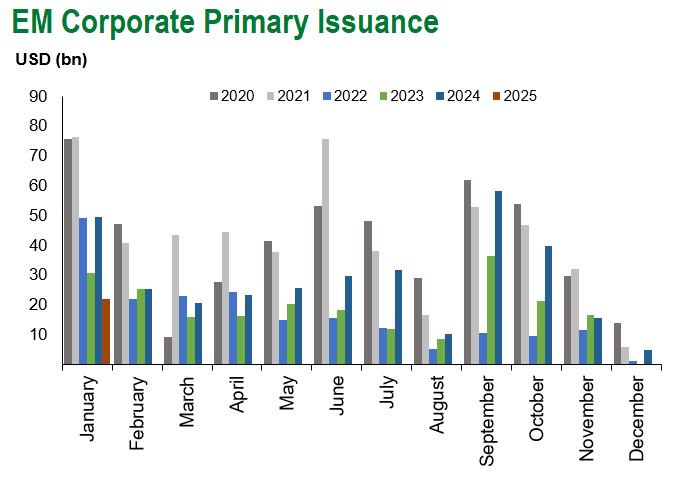
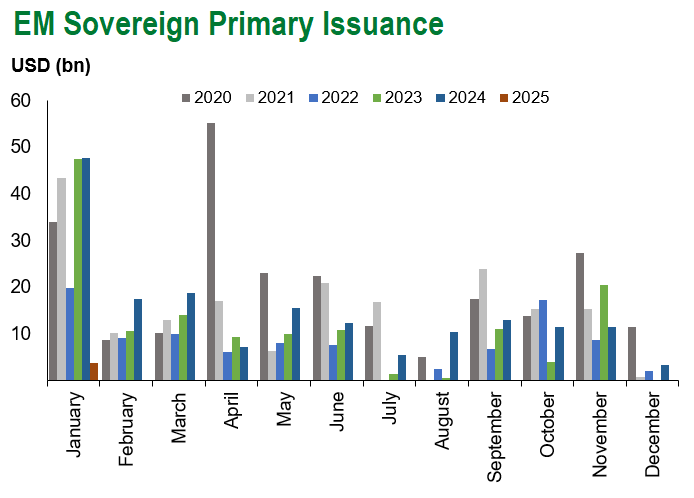
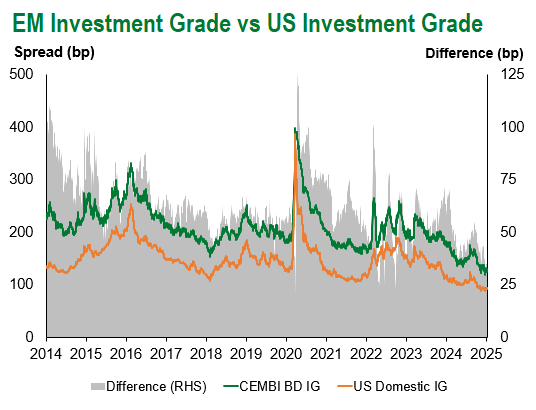
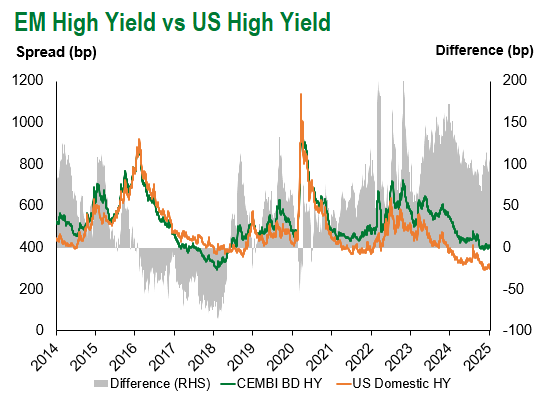
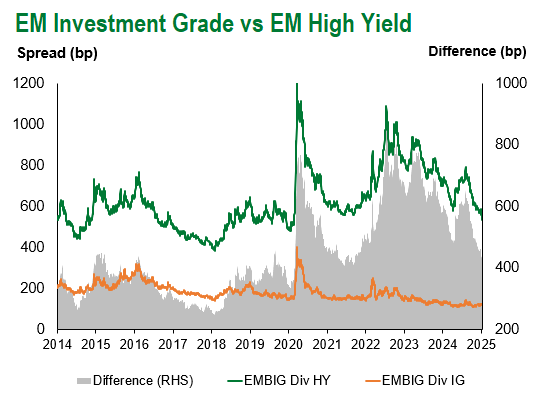
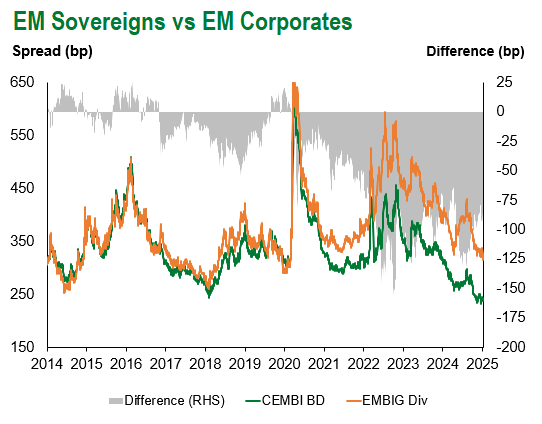
Emerging Markets Flows

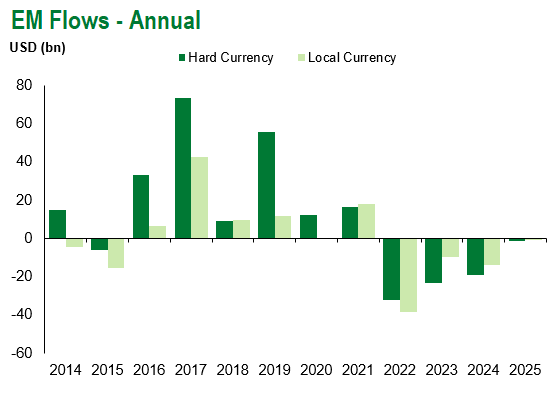
Source for graphs: Bloomberg, JPMorgan, Gramercy. As of January 10, 2025.
For questions, please contact:
Simon Quijano-Evans, Managing Director, Chief Strategist, [email protected]
Kathryn Exum, CFA ESG, Director, Co-Head of Sovereign Research, [email protected]
Petar Atanasov, Director, Co-Head of Sovereign Research, [email protected]
This document is for informational purposes only. The information presented is not intended to be relied upon as a forecast, research or investment advice, and is not a recommendation, offer or solicitation to buy or sell any securities or to adopt any investment strategy. Gramercy may have current investment positions in the securities or sovereigns mentioned above. The information and opinions contained in this paper are as of the date of initial publication, derived from proprietary and nonproprietary sources deemed by Gramercy to be reliable, are not necessarily all-inclusive and are not guaranteed as to accuracy. This paper may contain “forward-looking” information that is not purely historical in nature. Such information may include, among other things, projections and forecasts. There is no guarantee that any forecasts made will come to pass. Reliance upon information in this paper is at the sole discretion of the reader. You should not rely on this presentation as the basis upon which to make an investment decision. Investment involves risk. There can be no assurance that investment objectives will be achieved. Investors must be prepared to bear the risk of a total loss of their investment. These risks are often heightened for investments in emerging/developing markets or smaller capital markets. International investing involves risks, including risks related to foreign currency, limited liquidity, less government regulation, and the possibility of substantial volatility due to adverse political, economic or other developments. References to any indices are for informational and general comparative purposes only. The performance data of various indices mentioned in this update are updated and released on a periodic basis before finalization. The performance data of various indices presented herein was current as of the date of the presentation. Please refer to data returns of the separate indices if you desire additional or updated information. Indices are unmanaged, and their performance results do not reflect the impact of fees, expenses, or taxes that may be incurred through an investment with Gramercy. Returns for indices assume dividend reinvestment. An investment cannot be made directly in an index. Accordingly, comparing results shown to those of such indices may be of limited use. The information provided herein is neither tax nor legal advice. Investors should speak to their tax professional for specific information regarding their tax situation.
